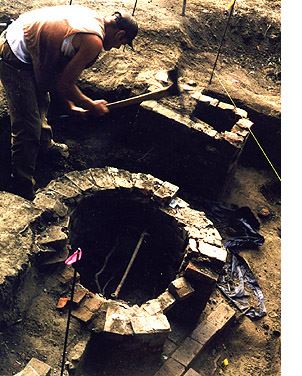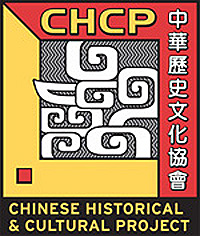|
- Home
- A Woolen Mills Chinatown Arch Jnl-6
A Woolen Mills Chinatown Archaeologist’s Journal -6
By Anmarie Medin, M.A.
Week of June 7, 1999: Roasting Kettle?
Rebecca has been writing a little bit about one of our more interesting finds. We’ve been calling it a “roasting kettle” because it was designated that on the 1891 Sanborn map. We have researched a variety of sources and found no conclusive evidence for why this structure was called that. Historian Connie Young Yu thinks the Sanborn mapmaker may have come by when the Chinese were cooking for a festival. Depending on the time of year, the “kettle” could have been used to cook communal dishes that were important for celebrating certain festivals. She remembers her father traveling to Watsonville to get a vegetable dish important to eat during Chinese New Year celebrations. If you have any stories or ideas on how this “roasting kettle” was used, tell info@chcp.org.
Finding and Excavating the “Kettle”
When we saw the two “roasting kettles” depicted on the Sanborn map, we knew we wanted to excavate them in order to understand their use by the Woolen Mills community. The “kettles” were located between the buildings and the river, near the backyards of residential buildings. Our research indicated no other archaeologists had excavated or described such a phenomenon, so we were quite interested in what we might find. We used the historic Sanborn maps to figure out where exactly to dig. Once we knew where the city blocks lay, we mapped in both kettle locations. The area behind Sanborn Block #2 was extensively disturbed during construction of the 1950s era Taylor Street bridge, and no archaeological deposits survived in that area. We moved over to the area behind Sanborn Block #1 and tried our luck. We started digging with the backhoe and very quickly found some bricks. We used the backhoe to remove the overburden, i.e. the dirt above the structure, and then switched to hand excavation so we could be more careful.
What We Found
 Archaeologist Bryan Mischke excavated around the structure and eventually exposed a round brick structure resting on a flat brick floor. The floor is made up of brick laid end-to-end in 11 rows of side-to-side horizontal brick. A cylindrical brick structure rests on this brick floor. The “kettle” mentioned by the Sanborn mapmaker may have been a cast iron pot suspended above this brick structure or a cast iron wok. The structure consists of bricks laid side-to-side, ends to the center, fanning out to create a circle. The top portion was disturbed, probably during road construction. The bricks were constructed with a “mouth”, an opening left in the bottom and capped by a flat metal bar, for cleaning out ash and debris.
Archaeologist Bryan Mischke excavated around the structure and eventually exposed a round brick structure resting on a flat brick floor. The floor is made up of brick laid end-to-end in 11 rows of side-to-side horizontal brick. A cylindrical brick structure rests on this brick floor. The “kettle” mentioned by the Sanborn mapmaker may have been a cast iron pot suspended above this brick structure or a cast iron wok. The structure consists of bricks laid side-to-side, ends to the center, fanning out to create a circle. The top portion was disturbed, probably during road construction. The bricks were constructed with a “mouth”, an opening left in the bottom and capped by a flat metal bar, for cleaning out ash and debris.
Bryan found three posts spaced around the brick floor (at the corners) that are probably remnants of a shade awning over the structure. In the dirt around the bricks we found a great deal of large mammal bone. The inside of the brick round feature was filled with ash, sandy soil, and many artifacts such as broken ceramics, more bone, and glass. As Bryan continued to dig down, he came across a cast iron pipe running across the cylinder and ending inside it with an “elbow” pipe joint turning up at its end. The end of the pipe going into the brick was bent and broken and it was impossible to see if the pipe had once been connected to something else. We thought the pipe might have been for a gas-fed burner to do the actual cooking, but it was not on the bottom as one would expect for more efficient cooking. In addition, there was a large quantity of ash around the kettle and downslope towards the river that was the residue of cleaning out fires. (See Week of May 17 about how people threw out their trash.)
Research Continues
We are now researching this archaeological feature to gain a better understanding of how it was used. Connie is reviewing literature on Chinese communities to find references to “roasting kettles” or community cooking areas. The archaeologists are reviewing excavation reports on other Chinatowns to see if anyone else has described a similar feature but given it a different name. Again, if you have any stories or ideas on how this “roasting kettle” was used, please respond to info@chcp.org. We can use the help…..
Back to (Journal -1) Week of April 26, 1999: Is Archaeology Glamorous?
Back to (Journal -2) Week of May 3, 1999: Surprises and Ceramics
Back to (Journal -3) Week of May 10, 1999: Field Photos
Back to (Journal -4) Week of May 17, 1999: Uncovering a Sense of Place and Space
Back to (Journal -5) Week of May 24, 1999: Fieldwork Wraps Up
Foward to (Journal -7) Week of July 26, 1999: Lab Work in Progress
Working with Caltrans are archaeological consultants from the firms of Past Forward, Inc., KEA Environmental, Inc., Foothill Resources, Inc., PAR Environmental, Inc., and the University of California, Chico.

